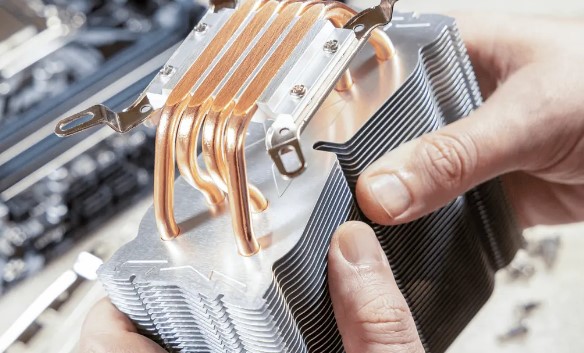Explained Simply: What Are Heat Pipes in CPUs and GPUs

If you’ve ever asked yourself what are heat pipes, you’ll find the answer inside almost every modern CPU and GPU. Heat pipes are specialized cooling components that transfer heat away from powerful processors, helping them run smoothly without overheating. They use a phase-change process to transfer heat efficiently, which is important for high-performance devices like gaming PCs and laptops. In this article, we’ll break down how heat pipes work, why they’re so effective, and the role they play in keeping your computer stable and reliable.
What Are Heat Pipes
Heat pipes are simple yet highly efficient devices used to transfer heat from one place to another. They are commonly found in electronics, renewable energy systems, satellites, and industrial equipment. Their main purpose is to keep components cool and prevent overheating. A heat pipe works using a phase-change process. Inside the sealed metal tube is a small amount of liquid and a wick lining.
When one end of the pipe absorbs heat, the liquid inside evaporates into vapor. This vapor quickly moves to the cooler end, where it releases heat and turns back into liquid. The wick then returns the liquid to the hot end, and the cycle repeats continuously. Since this process happens naturally, heat pipes can move heat much faster than solid metals, all without using moving parts or electricity.
In short, a heat pipe is a smart and reliable way to move heat, keeping modern technology cool, stable, and performing at its best.
How Heat Pipes Work
A heat pipe works using two main principles: phase change and heat transfer. When one end of the pipe gets hot, the liquid inside absorbs that heat and turns into vapor. This vapor then moves to the cooler end of the pipe, carrying the heat with it.
At the cool end of a heat pipe, the vapor releases its heat and condenses back into liquid. The liquid then flows back to the hot end through a sponge-like layer called the wick, using a natural process known as capillary action. This continuous cycle of evaporation and condensation efficiently moves heat without any moving parts or extra energy.
A heat pipe has three main components:
- Shell – the sealed outer tube that holds everything together and protects the inside
- Wick structure – a porous material that helps return the liquid to the hot area through capillary action.
- Working fluid – a liquid that carries the heat by changing between liquid and vapor.
Heat pipes efficiently move heat through a repeating cycle of liquid turning to vapor and back, making them essential for cooling electronics, aerospace systems, and industrial equipment.
Why Heat Pipes Are So Effective
Heat pipes are highly effective because they can move heat quickly and efficiently without needing any moving parts or external power. Their secret lies in the phase-change process and capillary action, which together allow them to transfer heat much faster than solid materials like copper or aluminum.
When a heat pipe heats up, the liquid inside turns into vapor at the hot end and moves to the cooler end, carrying a lot of heat with it. This method is much more efficient than just passing heat through a solid. The wick inside the pipe naturally brings the condensed liquid back to the hot end, allowing the process to continue on its own.
Because of this design, heat pipes can:
- Transfer large amounts of heat quickly over long distances.
- Operate silently since they have no moving parts.
- Work in any orientation (depending on wick design).
- Compact and lightweight, ideal for modern electronics and aerospace applications.
Heat pipes are so effective because they combine high thermal efficiency, reliability, and simplicity, making them one of the best solutions for cooling high-performance systems.
Types and Variations of Heat Pipes in PCs
Heat pipes are essential components for efficient thermal management and come in different types to meet various cooling needs. Understanding the characteristics of standard heat pipes, vapor chamber heat pipes, and loop heat pipes is key to selecting the right solution for applications ranging from everyday electronics to advanced aerospace systems.
- Standard Heat Pipes
Standard heat pipes are the most common and versatile type. Their simple design and reliable performance make them ideal for general-purpose heat transfer. Widely used in electronic devices and cooling systems, they efficiently manage heat to ensure devices operate smoothly and last longer.
- Vapor Chamber Heat Pipes
Vapor chamber heat pipes are designed to spread heat evenly across large surfaces. They are perfect for high-performance computing systems, GPUs, and LED lighting, where hotspots can harm performance or damage components. Their design allows them to handle higher heat loads while maintaining uniform cooling.
- Loop Heat Pipes
Loop heat pipes are compact and lightweight, making them ideal for space-constrained environments such as aerospace or advanced electronics. They efficiently transfer heat in tight spaces where standard heat pipes may not fit, making them crucial for applications where size, weight, and performance are critical.
Each type of heat pipe is engineered to address specific cooling challenges, giving designers flexibility to optimize thermal management across a wide range of devices and environments.
Real-World Examples in Computer Cooling
Heat pipes are essential for managing heat in modern computing devices. They efficiently transfer heat away from critical components like CPUs and GPUs, preventing overheating and maintaining performance.
- Gaming Laptops: Powerful gaming laptops feature multiple heat pipes that help cool both the CPU and GPU, preventing overheating and ensuring smooth performance during extended gaming sessions.
- Desktop CPU Coolers: Tower and low-profile coolers rely on heat pipes to provide effective cooling, balancing performance and space constraints.
- GPU Cooling Systems: Modern graphics cards use heat pipes, sometimes in combination with vapor chambers, to evenly distribute heat and enhance cooling efficiency.
Heat pipes play an important role in ensuring reliable, efficient, and quiet thermal management in high-performance computing systems.
Benefits for Performance and Reliability
Heat pipes offer significant advantages in both performance and reliability, making them essential in modern electronics and high-performance systems.
Performance Benefits
- Efficient Heat Transfer – Heat pipes move heat much faster than solid metals, keeping components cool even under heavy workloads.
- Even Cooling – The phase-change process maintains a nearly uniform temperature, preventing hotspots and ensuring consistent performance.
- Flexible Orientation – Heat pipes work in any position, making them ideal for laptops, satellites, and other devices where orientation may change.
Reliability Benefits
- No Moving Parts – Operating passively without fans or pumps reduces mechanical failure and increases system reliability.
- Durable Design – Heat pipes withstand high temperatures and repeated thermal cycles, maintaining performance over time.
- Leak-Free Operation – Properly sealed heat pipes prevent fluid leaks, ensuring safe and stable long-term operation.
Heat pipes enhance system performance by transferring heat efficiently and improve reliability by offering durable, maintenance-free cooling.




